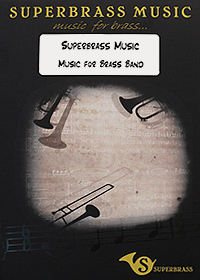11+ Brass Ensemble,
18-Apr-2006Hadleigh Temple,
Saturday 8th April
The 11+ Brass Ensemble is made up of brass players based in the London area, and includes members of several military bands, together with students and free-lance players. This concert, their second visit to Hadleigh, was arranged by Anthony Sommerville, euphonium player with both Hadleigh Temple Band and the Grenadier Guards, to raise money for Cancer Research UK.
Although calling themselves the 11+ Brass Ensemble, they actually commenced the programme as 11 minus (11 – 6 actually) as their quintet played Malcolm Arnold's "Brass Quintet, Op 73". Written in 1961 for the New York Brass Quintet, its opening is particularly well-known from its numerous appearances as theme music on the airwaves. The five players caught the sense of impishness inherent in the music well, from the opening interplay between the two trumpets, before they were joined by the more mellow tones of the horn, trombone and tuba. Later on, it was the tuba player's turn to join in the fun which always seems to lurk just below the sometimes melancholy surface of Arnold's music, and this attractive and accessible music proved a popular choice.
The quintet doubled in size for the rest of the first half of the programme, played by the group's dectet (4 trumpets, doubling where required, including flugel, french horn, 3 trombones, euphonium, tuba), with the addition of percussion where appropriate. John Williams has received many plaudits for his music for the "Star Wars" films, and although "Star Wars Episode 1" had its critics it did include some more memorable music. "Duel of the Fates" had been arranged by trumpeter Craig Bennett and called for much precision as answering phrases were tossed between one instrument and the next, all building on the firm foundation provided by the tuba. There was some effective writing for the french horn, particularly when paired with the flugel.
Bizet's opera "Carmen" is just one of many works which have gained universal acclaim despite an inauspicious start. It received a somewhat cool reception from both the public and the critics at its premiere in 1875, just 3 months before the composer's death, but has grown in popularity over the years in both French and Italian language version, not to mention its transition into "Carmen Jones". The opera contains many familiar melodies, and the suite presented by the ensemble consisted of five movements.
The "Aragonaise", complete with prominent tambourine, conveyed a real dance flavour, with some tidy decoration from the piccolo trumpet. "Les Dragons d'Alcala" is typical of the light-hearted military music used to accompany Don Jose in Act 1 of the opera, and featured a stately opening on horn, with deft interaction between the trumpets and trombones, particularly when the trombones provided a walking bass beneath the trumpet melody. The "Habanera" was started off by the tuba, setting the rhythm in place for the well-known tune, first on trumpet and then in duet form with muted trumpet and flugel, before passing on to piccolo trumpet and horn, with a hefty tuba pedal note drawing the dance to a close. "La Garde Montante" is sung in the opera by the gang of urchins who gather around the soldiers on parade. The arrangement featured trumpet fanfares, muted then open, followed by the piccolo trumpet imitating the playful youngsters, underpinned by fast runs from flugel and horn.
Lastly came the "Danse Boheme", familiarly known in its Carmen Jones incarnation as "Beat out that rhythm on a drum". A trumpet duet, accompanied by trombones and euphonium, led into the pairing of flugel and horn. By now the ensemble were well and truly into their stride, and despite the occasional lapse of intonation from the trumpets, they brought a real feeling of excitement as the music grew more frenetic towards the end.
Supporting the brass ensemble, and providing a welcome change of timbre, was Hadleigh vocalist Charlotte Still. For her first song, "People need the Lord", she was joined by Peter Worth at the piano, whilst "I know you by heart" was sung to her own piano accompaniment.
In between her two songs, an appeal was made on behalf of Cancer Research UK, a and a collection was taken. During the playing of the collection, the 11+ Brass Ensemble let their hair down somewhat with Pee Wee Ellis's "The Chicken", complete with fine solo work from Richard Tuddenham (trombone), Craig Bennett (trumpet), and Nathan Gash (tuba). The riffs and ensembles were tight whilst retaining the right improvisatory feel, and both players and audience seemed to enjoy the change in style.
Throughout the evening, announcements were kept to a minimum, with information about the music – not to mention some tongue-in-cheek biographies of the players – being projected onto a screen above the platform. Thus it was explained that "Black Sam" was a cat belonging to Chris Hazell, producer of a number of recordings for the Philip Jones Brass Ensemble. Chris was inspired to pen musical portraits of several of his cats, and "Black Sam" was notable for some particularly fine playing from the trombones, making the most of their opportunity to shine, with some full, fruity notes from the bass trombone. With a steady pulse and a suitably laid-back feel it was first class ensemble playing, with the flugel and piccolo trumpet each adding their distinctive tones when appropriate.
Wilfred Heaton wrote "Toccata" for a brass sextet to be played on an overseas trip in 1938, and it was later revised for full band (without percussion), appearing in print in 1973. Denis Wick subsequently arranged it for brass dectet, and this formed the final item before the interval. It would be interesting to hear the original sextet version to see how it compares with the more familiar full band scoring.
The arrangement for ten-piece presents many challenges to the players, not least calling for precision if the lines are to come across clearly, and in this respect the performance seemed a little under-rehearsed. The opening, driving, rhythms were maintained well, with a hefty bass sound, which occasionally became a little too heavy for the ensemble. The tuba and trombones produced some finely judged dynamic rises and falls in the slower central section, but some of the entries elsewhere were lacking in confidence. The reprise of the opening was marked by some clean work from euphonium and horn, but a little more rehearsal time would undoubtedly have made for a more effective reading.
After the interval, Charlotte Still opened the second half with Eva Cassidy's version of "Somewhere over the rainbow", a very moving rendition to her own piano accompaniment. She was joined by Peter Worth for her final contribution, the song "All that jazz!" from the musical "Chicago". Even losing her place towards the end didn't throw her for long, and despite seeming a little self-conscious, she communicated well with the audience.
The final contribution from the brass ensemble consisted of Paul Archibald's arrangement of 10 movements from Prokofiev's music for the ballet "Romeo and Juliet". This used an expanded group, with 5 trumpets, 4 horns, 3 trombones, euphonium, 2 tubas and plenty of percussion, and for this they were conducted by Tom Hammond. Craig Bennett, entrusted with the fearsome piccolo trumpet part, confided afterwards that he had listened to Paul's 1988 recording of the work as part of his preparation, only to find that the piccolo part had been revised, with a number of passages going up the octave!
The opening "Folk Dance" displayed much of the quirkiness of Prokofiev's natural style, together with some of the fun often found in Russian folk music. The tuned percussion played a prominent role, as did both Eb and piccolo trumpets, with solos for euphonium and tuba as well. The ensuing "Scene" featured muted trombone and piccolo trumpet, with a passage in octaves from the two tubas.
Prokofiev's "Minuet" is somewhat more vigorous than any encountered in Haydn and Mozart, but the ensemble conveyed the stately character of the dance well, with a trumpet solo in broad, typically Russian style, whilst grace notes from the trumpets and horns were tucked in neatly. "Juliet the girl" is portrayed as a carefree, sprightly creature, with brisk scales and lively figures passing from one instrument to the next. In the slower central section the high, muted piccolo part was carried off well, as were the ensuing solos for euphonium (played on the original recording by Robert Childs) and horn.
"Masks" brought some well-placed trills and ornamentation throughout the ensemble before the somewhat menacing depiction of the "Montague and Capulets", with its galumphing arpeggio-like figures and growling bass line. This was one movement where one missed the colours of the original instrumentation, although the euphonium made a fair substitute for the tenor sax, and the four horns produced a fine sound. This was definitely one instance, however, where the tubas were a little too strident.
For "Father Lorenzo" Prokofiev made use of original chimes heard in Verona, and there was some effective work on the vibraphone supporting the sustained brass chords and extended melodic lines. The lively "Mercutio" was played crisply with carefully placed accents, whilst the trumpet runs over the tuba melody dove-tailed nicely together. The "Dance of the lilies" produced some good interplay between trumpets and percussion, backed by the trombones.
The final movement, "Romeo and Juliet before parting", was another test for the piccolo, opening with a high muted solo against a sustained accompaniment from the ensemble. Considerably longer than any of the other sections, this was the emotional core of the suite, and the players captured well the subtleties of the writing, portraying the tenderness between the lovers and the poignancy of the situation. The horn writing was at times reminiscent of John Williams in his more heroic mood, and the arranger makes the most of the range of the instruments available to him by setting a low tuba against high trumpets, with some tricky repeated semiquavers to tuck in. When the music came to its rather subdued close, there was a short pause as the audience wondered whether that was indeed the end before they greeted the ensemble with warm applause.
A cheque for £350 was handed over to cancer research UK, although the amount raised has since topped the £500 mark. Anthony expressed his thanks to all those who had made the evening a success, with a particular mention for their conductor, and the ensemble ended the evening with a reprise of "The Chicken". To have put on such an ambitious programme with limited rehearsal time was quite an achievement, and bodes well for the group's future. Perhaps the next programme will give the fine trombone section a little more to get their teeth into, and an extra rehearsal could tidy up the occasional lapses in ensemble and intonation in the trumpets, and turn a fine performance into a superlative one.
Peter Bale









